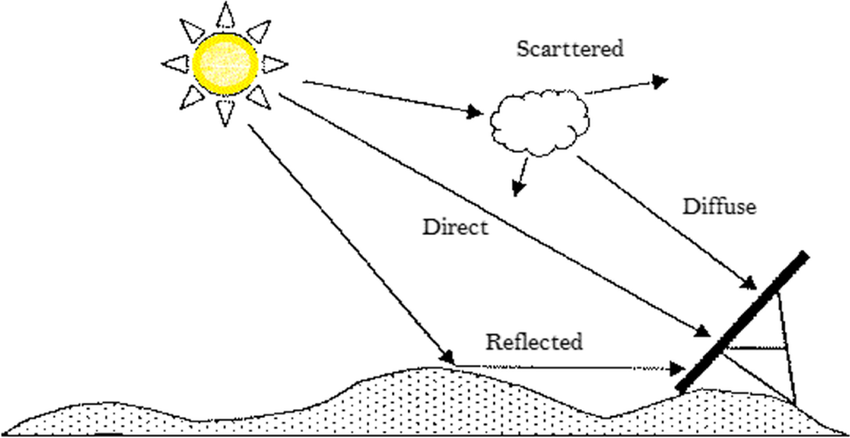Solar irradiance refers to the power per unit area received from the Sun in the form of electromagnetic radiation in the Earth’s atmosphere or at the surface. Measured in watts per square meter (W/m²), solar irradiance is a critical concept in meteorology, climatology, solar energy, and environmental science fields. Understanding solar irradiance is essential for the design and efficiency of solar power systems, as well as for climate modeling and weather forecasting.
Types of Solar Irradiance
Solar irradiance can be categorized based on its interaction with the Earth’s atmosphere:
Direct Solar Irradiance: This is the solar radiation that reaches the Earth’s surface directly from the Sun without being scattered or absorbed in the atmosphere. It is most intense when the sun is directly overhead and decreases as the sun’s angle to the surface decreases.
Diffuse Solar Irradiance: This component of solar irradiance reaches the Earth’s surface after being scattered by molecules and particles in the atmosphere. The sky’s blueness and the illumination of areas not in direct sunlight are due to diffuse irradiance.
Global Solar Irradiance: This is the sum of direct and diffuse solar irradiance that reaches the Earth’s surface. It represents the total power per unit area available from the sun and is a key factor in determining the potential of solar energy systems.

Irradiance varies throughout the day and year, influenced by factors such as the angle of the Sun above the horizon (solar elevation angle), atmospheric conditions (cloud cover, air pollution), and the geographical location’s latitude and time of year. Understanding solar irradiance is essential for designing and optimizing solar energy systems, such as photovoltaic (PV) panels and solar thermal collectors, to maximize their efficiency and energy output.
Before the sunlight enters the atmosphere, the irradiance is around 1368 W/m^2 (which is a standard value). In the atmosphere, there’s interaction with the N2, O2, etc. molecules.
On clear-sky days, irradiance can be as high as 1000 W/m^2 on the ground. Higher values can occur though, due to the reflection by clouds.
On cloudy and overcast days, at noon e.g., irradiance can be 100 W/m^2 or lower (compared to 1000 W/m^2).
Importance of Irradiance in solar energy production.
The importance of irradiance in solar energy production is fundamental, as it directly influences the amount of solar power that can be generated by solar energy systems such as photovoltaic (PV) panels and concentrated solar power (CSP) plants. Here are several key reasons why irradiance is crucial in solar energy production:
Determines Energy Output: The amount of electricity a solar panel can produce is directly proportional to the solar irradiance it receives. Higher irradiance levels result in higher energy output from the solar panels. This relationship makes understanding and measuring irradiance essential for predicting and optimizing the performance of solar energy systems.
System Sizing and Planning: Accurate irradiance data is crucial for the proper sizing and planning of solar installations. Engineers and planners use historical irradiance data to estimate the expected solar energy production in a specific location, which helps in determining the size and number of solar panels or mirrors required to meet energy demands.
Efficiency Evaluation: By comparing the actual energy output of a solar system to the expected output based on irradiance levels, operators can evaluate the system’s efficiency. This analysis helps in identifying potential issues, such as shading, dirt accumulation on panels, or equipment malfunctions, which may reduce the system’s performance.
Economic Analysis: Irradiance data plays a vital role in the economic analysis of solar energy projects. The potential return on investment (ROI) and payback period of a solar installation depends significantly on the site’s irradiance levels and the energy output of the system. Higher irradiance levels can lead to faster ROI due to increased energy production.
Energy Management and Grid Integration: Understanding the variability of solar irradiance, including daily and seasonal patterns, is essential for energy management and the integration of solar power into the electrical grid. This knowledge helps in forecasting solar energy production, managing supply and demand, and ensuring the stability and reliability of the power grid.
Location Assessment: Irradiance varies significantly with geographic location, elevation, and local climate conditions. Assessing the solar irradiance of potential sites is crucial for selecting the most suitable locations for solar energy projects to maximize energy production and project viability.
Irradiance is a critical factor in solar energy systems design, operation, and economic analysis. Accurate measurement and understanding of solar irradiance enable the efficient and effective harnessing of solar energy, contributing to the broader adoption of solar power as a sustainable and renewable energy source.

